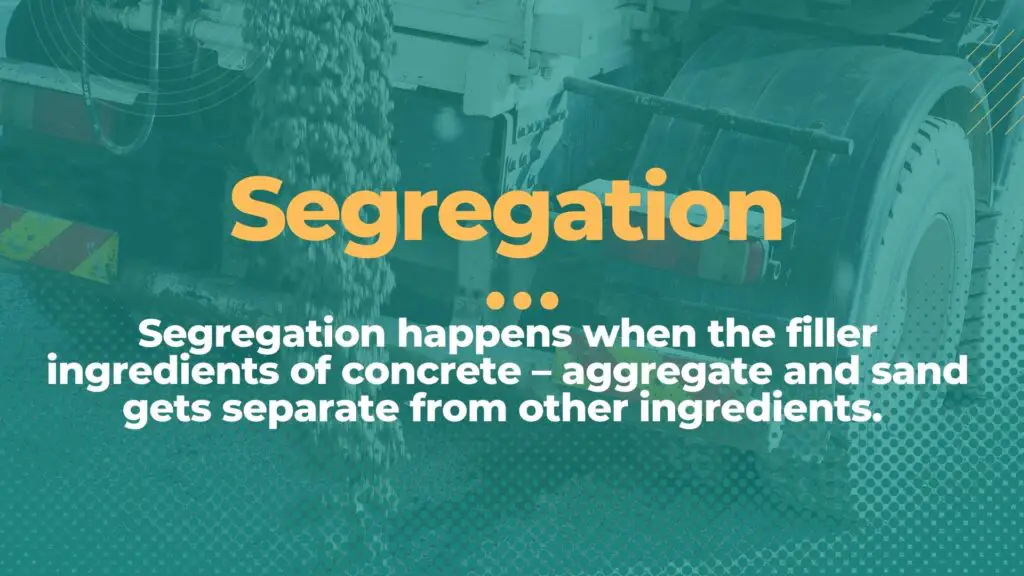Segregation and bleeding are two of the most common flaws that significantly impact the concrete quality. But it is critical to understand the difference between segregation and bleeding. These two flaws result in a different set of symptoms. Do you know what is the difference between segregation and bleeding?
Both impact the workability and strength of concrete. So, one must also know how to avoid segregation and bleeding in concrete.
Segregation is the separation of the aggregates from that of the cement slurry whereas bleeding is the separation of water and rising to the surface of the concrete pour.
Segregation generally happens when the fall of concrete pouring is excessive whereas bleeding occurs when excessive water is added or as a result of over vibration during concrete compaction.
But that’s not all, there’re so many other distinct features or patterns that must be understood well before going for concrete pouring.
We know concrete is an amalgam of different ingredients. It comprises of a cement, sand, aggregate, and water. But to achieve proper compressive strength and for high quality, all these ingredients must have to form a homogeneous matrix.
If you use only gravel and don’t have sand in concrete, there’ll be large amount of voids. This will significantly reduce the compressive strength of concrete. So, we need to make sure; the cement slurry binds well the all the concrete ingredients.

Segregation
Segregation happens when the filler ingredients of concrete – aggregate and sand gets separate from other ingredients. It mostly happens when you have excessive height of concrete fall. Aggregates being the heavy weight fall as separate and start accumulating at the bottom of the pour.
Causes of segregation
As a result of segregation, the concrete mix no longer behaves as a homogeneous mix. Most of the reasons of segregation are relevant to handling, transportation, and placing of concrete. Another basic cause of segregation is excessive slump or loose slump. Also falling concrete from a far height results in segregation.
Also Read: What is slump of Concrete? Types- Factors effecting Slump
According to some codes like ACI, the maximum fall for concrete height is 1.5 meters. The recommended range for concrete pour is 3 to 5 feet or (0.9 to 1.5 meters). But depending on the slump of the pour, the limit may be as little as 2 feet or 0.6 meters.
Insufficient mixing of concrete may also result in segregation. I may not have to emphasize enough on why mixing of concrete is important.
We normally undergo concrete mixing by hand or by machine. Hand mixing is only preferred when doing small-scale projects like in concrete driveways or a flooring in small portion. Poor mixing of concrete can not only result in understrength structures but can also impact the quality of structure for long term.

Disadvantages of segregation
If you’re pouring concrete without working yourself to avoid segregation; you may put yourself in hassles like:
- Segregation can result in poor finish of concrete. It can result in appearance flaws like rock pockets, sand streaks, and porous layers.
- Excessive slump or water in the concrete mix can come on the top of the surface that can result in shrinkage cracks.
- As a result of segregation, you may not be able to properly compact the concrete. As a result, the pour will have drastic reduction in compressive strength.
- You’ll have higher density of coarse aggregate in lower part of the column or a beam. This non-uniform distribution of concrete strength can decrease the performance of member to withstand the working loading.
- If segregation happens, you’ve got to engage more labor to repair and maintain bad quality concrete.
Also Read: Concrete Leveling – Everything you need to know [7 FAQ]
How to avoid segregation?
Experts recommend using chutes while pouring concrete. You’ve got to allow transit mixer to come as close to pour as possible. But that’s not always possible. For such, you can use chutes to avoid segregation.
Always try to undertake apt amount of compaction, regardless of the method you’re using for concrete compaction. Such concretes have considerably reduced abrasion resistance and strength as well. If you’re using a poker or internal vibrator, we recommend withdrawing it very slowly at a rate of around 1 inch per second. More vibration is only needed if you can see bubbles emerging from the concrete as long as you withdraw the vibrator.
Also Read: Compaction of Concrete – Importance – Under – Over vibration – PDF
Always use recommended size of coarse aggregate in concrete. These aggregates are larger than 4.75 mm (retained on a No. 4 sieve). But the gradation of aggregates must relate well with the compressive strength requirement of concrete.
Bleeding
When water escapes the concrete matrix and start rising to the surface in the shape of white foamy cement slurry; this is known as bleeding. Cement and water mix up result in hydration reaction during setting. But if you add excessive water during mixing of concrete ingredient, it will rise up to the surface.
The aggregates, cement, and sand has some ability to take water so if you add excess water, it will leave it resulting in bleeding.
The excess water will take most of the cement past and deprive the aggregates from cementitious material. The same process happens when we undergo over vibration during concrete compaction.
The water slurry on the top of concrete will eventually evaporate leaving behind exposed aggregates and resulting in drying shrinkage cracks.
Also Read: What is Water Cement Ratio? – Guide – Calculation
Effects and tricks to avoid bleeding
- Bleeding will result in understrength concrete. It will lose all fines resulting in porous and week layer at the top.
- You can avoid bleeding by ensuring proper proportioning and uniform mixing of concrete matrix.
- Also try to avoid over vibration of the concrete.
- You can also reduce the chances of bleeding by making use of pozzolanic materials and air entraining agents.
- Bleeding can cause the concrete to loose homogeneity that is the essential quality of a concrete mix.
- Fineness of cement also has an impact on bleeding. You can reduce the chance of bleeding by using high fineness of cement.
- You can test the concrete mix by using fly ash in the concrete. But there’s no short formula to determine the recommended amount of fly ash. You’ve got to hit and try.
- If you’re working on water-retaining structures; you’ll make sure there’s no bleeding in concrete walls or slab. Otherwise, the components will be porous resulting in leakage.
- If you’re working on a mass concrete structure like a dam, the bleeding will result in poor bonding between two subsequent layers of concrete.
- Due to bleeding, you may not be at ease while finishing and curing the concrete mix.

Summary
I’ve summarized the above information, for you to save it somewhere for future reference:
| Point | Bleeding | Segregation | |
| 1 | It means the separation of water from the remaining mass of concrete. | It is the separation of aggregates and other ingredients from each other. | |
| 2 | It is mostly caused because of the over-vibration of concrete | The reason of segregation is improper mixing of concrete materials and placing of concrete from a height above 1.5 m. | |
| 3 | It leads to creating a honeycomb in concrete and decreases the strength. | It makes concrete porous and decreases its strength of concrete. | |
| 4 | It cannot be repaired after formation. | It can be repaired. |
Also Read: Can You Pour Concrete in rain? (Steps and precautions)
Key takeaways
Both segregation and concrete impacts greatly the quality of concrete. For the concrete pour to achieve the desired compressive strength, you need to avoid segregation and bleeding.
Segregation is the separation of filler ingredients of concrete whereas bleeding is the rising of cement slurry to top of the concrete pour.
Further Read: Rock Salt Concrete Finish – Installation – Advantages – Cost


















